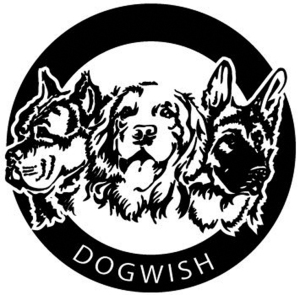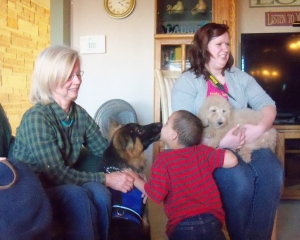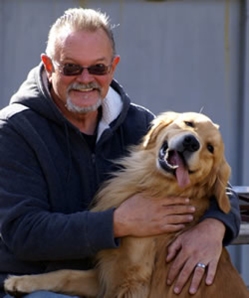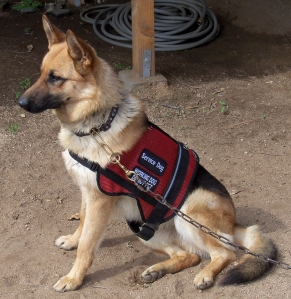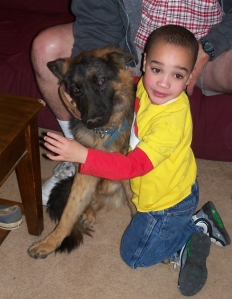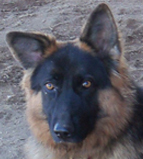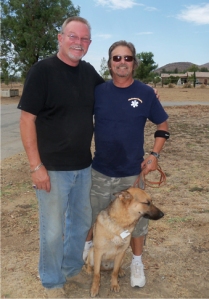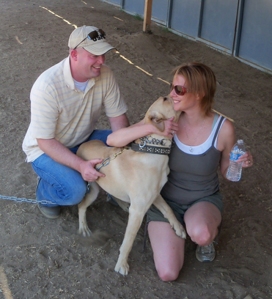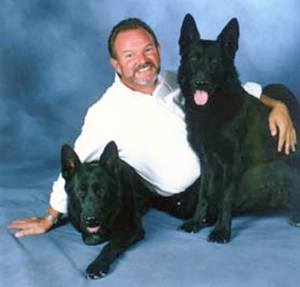We live in a world full of artificial experiences, and are being conditioned to think in terms of a world full of simulated, synthetic, generic typed, reproduced, imitation, push buttoned, instant responses and gratifying experiences. Unfortunately our abilities and natural functionality are becoming a thing of the “past”. In our world today, one in four people is surviving acute anxiety and trauma that has altered their life, and disabled their personal capability to function as a normal human being. The privilege and ability to reach out and connect with another living being, like a dog, has become a phenomenal experience that many claim is literally transforming and saving their lives. As we race towards a “Steve Job, Bill Gates” type of life experience, we are being forced to adapt to a world full of technological complexity that is out of perspective, and out of control. While we sit back and talk about Autism and its effect on those with Developmental Disabilities, we have no idea, for the most part, of how greatly we have been and already are being affected by this very critical element surfacing in our society. It is fascinating to see how the different elements of our society, even our politics, are being changed by the infusion of the energies caused by this phenomenon.
For instance, many of our clients come here and expect that somehow we have implanted an artificial intelligence and ability, within their dog, that will multiply its’ capabilities to provide instant responsiveness to their numerous disabilities, and their decreasing abilities. The more we rely on the artificially created world provided for us to purchase and use, the less we do ourselves, and the more incapable we become. At Dog Wish we believe in a natural flow of cosmic energy that pervades the universe, connects us all, teaches, and heals us, as we use it. It is the natural miracle of connectedness, through the energies available to all of us, that is precious and wonderful.
Our new understanding and usage of “energy” is changing our world because of the contrast it brings us between what is real and living and what is artificial and simulated. The tendency in our created world of technology is to shut down, shut off, separate, stop feeling, stop experiencing, and become disassociated and remote. Learning to reconnect, to become sensitive to feelings and energy of your body, to the energy in the bodies of others, in other animals, and then in the world, is something we all need.
DO OUR DISABILITIES COME FROM A UNIVERSAL CAUSE?
I have for years believed that Autism is a dominant, and NOT a recessive factor. As we continue to progress it is obvious that Autism is part of a dynamic living and growing evolvement in the human species. This evolvement is transforming our world in many ways, and this phenomenon is becoming a major part of that evolvement. I have to also believe that the recent trends in Alzheimer’s, Huntington’s, Parkinson’s and other like diseases and disorders which seem to be having a multiplied effect on our species, are related and developing in an expedientially clock wise fashion universally for our species.
One of the unique and fascinating phenomenon created by a brain affected by Autism is the way that brain assimilates and uses sensory information. Biological Science tells us that the “Purkinje Axiom and Fiber are responsible to work as an extension of the bodies Central Nervous System, to transfer energy to every cell in the brain. The diversified quality of sensitivity to energy in the Purkinje is one of the major causes of disabilities and disorders that we suffer. A person affected by Autism usually assimilates information at a much higher level than someone without that disability would.
Second, they process that information using their right brain, and spend more time “right” than others would. I have chosen not to call this group abnormal, and others normal, because it is becoming more “normal”. Each year, with the phenomenal growth (1 in 5 now, and growing at 12 to 17% each year) of those with Developmental Disabilities on our planet, they are becoming more normal all the time. At the present rate, with two decades, our world will be experiencing a division between those who do and do not have a mentality affected by this disability.
A Good example today can be seen in the behaviors of two of NFL’s top Football Coaches, who happen to be brothers. Jim Harbaugh, and John Harbaugh. Jim coaches the San Francisco 49ers, and John the Baltimore Ravens. Jim Harbaugh demonstrates a strong tendency for Autism in his behaviors. He is a creative genius who has melt downs and demonstrates extreme emotional behaviors constantly on the football field. John, on the other hand, is intelligent, “in-control”, and thoughtful. This year the teams of these two brothers will be competing against each other in the “Super Bowl”, and it will be interesting to see which coaching “style” is more affective. Man, as a being, is conflicted by his mental, and primordial instinctual dimensions, comprising his behavior. Could it be that the phenomenon of Developmental Disabilities is a mental safeguard, built into the genetic chemistry of man’s brain, to keep him balanced and from evolving beyond himself?
As a young dog trainer, competing on an international, “super” level, in dog sports, I became interested in the relationships between dogs and humans, a phenomenon that I have been fascinated by for forty years now. Living in an artificial world, where reality is reproduced for us through man-made technological devises, we live more and more through technical devices that bring us a simulated living experience. Man, who is being now treated, and who has begun to feel like, a piece of technology, is desperately looking for an experience that will help connect them with reality.
As I continued to research and study I realized that this phenomenon was made possible by the transference of energies we both held in common through the universal environment around and within us. I have, since, read everything I could find on the subject from the sciences of biology, psychics, and psychology.
- I strategized, designed, and created methods for teaching dogs to expand their sensory abilities from 2 to 5 times what they normally would be.
- I then created methods that taught dogs to stay focused on a single subject for several minutes at a time, instead of changing thoughts from one thing to the next, every couple of seconds.
- I then expanded the ability for the dogs to invert their sensory process, and use all their sensory abilities to understand what they perceived.
- This enabled the dogs to lose consciousness of their own life experience as they became involved in the conscious life experience of the person they were studying. The dogs actually would “get out” of themselves, and into their handlers, transferring their attention from them selves to other beings.
- The dogs learned to use their senses to focus on our energies (using hand and simultaneous brain (thought) communications), and began to see amazing results.
LEARNING TO HARNESS AND USE ENERGY
Basically, I have learned how to focus, introvert, expand, and use the sensory processes in dogs, to greatly increase their sensitivity and ability to respond to the energies in their human handler/trainers. In doing this the dogs naturally begin to use their left brain processes, expanding usage of their own neural synapse cranial transference abilities. This does not raise the intelligence of the dogs, but does teach them how to use their intelligence in ways that we as human can relate to, and connect with.
We are beings of energy, and as living beings, our bodies are comprised with several energy portals. Through energy transference we can easily connect with each other. Becoming sensitive to the energy in and around us is a healing, wholesome, and therapeutic activity. The smallest material particle in the Universe we have found, using 100,000 powered electron microscopes, is a little string we call a
“Photon”. Everything you know, see and feel is comprised of these minute photons. The very air we breathe is comprised of photons. The chair you sit it, cup you drink from, and bed you lie in, is filled with photons. Likewise, you are comprised of photons, configured according to your intentions. Your body was created by massing these little particles which were attracted to your energy and formed according to your will. Each photon is alive, living, responds intelligently to contact, receives, processes, and eliminates. Your physical body is basically masses and masses of photons, formed according to your genetic blueprints. Photons exist, live, and work through energy. So do you. By connecting with matrix bodies of positive energy in the cosmos around us, we train our dogs, using the positive energy that we are connected with, and projecting that energy into them.
We have, through the advanced use of advanced inductive logic processes, been able to understand, separate, and examine the actual thought “process” used by dogs, and in so doing have been able to identify the process they use to “create” their own thoughts and behaviors. I have encapsulated this process into component parts, and have broken them down into individual experiences. Over a twenty-one day process these behaviors become a solidified physical part of the dog’s brain, and through process.
Basically, using what we call the “Intention” process, the core of the dog’s “thought process”, we can predict and focus a dog’s thoughts and behaviors as we need and desire. In doing so, we can actually attack mental/emotional problems that the dogs, and their handlers, have endured throughout their lives, and provide resolutions for them not capable in other programs. We have for years witnessed “break-through” experiences with our dogs and their new handlers because of this.
Every dog is different, and responds to our training and conditioning in different ways. Instead of trying to force a dog to conform to our desires, we enter into their experience with them, and help each dog to use our training to its own best advantage. We have found that it is best to allow each dog to express their own personality, and to support them as they incorporate our training for their own personal development.
Our training and conditioning is based on a “team training“ philosophy. We do not employ dominance or force in our training. We also use a “pure” instruction philosophy that excludes punishment or negativity in our training. We believe in the dog’s ability and right to make, and to be responsible, for its’ own decisions. These training philosophies and procedures are only capable because of the strategy we use that creates, produces, and it based on working with the intelligence capabilities in each dog. Concepts like a “self-image”, mental “strategies”, and complex decision making are only capable in our training because of the way we have “created” these abilities in our dogs through our conditioning.
As a result of the energy work we do with each dog, we have for years been able to actually pair dog/handler teams together, synchronize them mentally, emotionally, and physically, and team them to work as a unified team. Every team experiences the results of this training to lessor r greater degree, according to their own personal ability to incorporate our training.
A year ago, I had a young man diagnosed with Asperger’s Syndrome whose family brought him to see me about getting a Service Dog. As many, many families do, they came to speak to me about the experience of getting one of my Service dogs, and to see what the dogs would be like. They had no idea what was going to happen, and didn’t expect for Caleb to respond as he was about to.
Caleb was a large, awkward, 15 year old, high schooler, quiet and rather introverted who sat behind the family, and very carefully looked around our facility. When addressed, he withdrew to a comfortable distance emotionally, and responded with a minimum response. I explained the process we use to match and place our dogs with client/recipient/handlers, and the family acknowledged that they understood. It was very cut and dry, comfortable, and non-stressed. All the time I was watching Caleb as he vegetated while we spoke, lost in a world between the world we lived in, and the world of his right-brained life experience. Though he was silent, he was saying so many things to me that it was hard to speak with the family. His needs, desires, frustrations, and hopes were screaming at me through the forms of energies that Caleb had attached himself to.
I finally decided to “introduce” the family to a dog. I had a large yellow lab in the back of my dog kennel who shared his kennel space with a couple young female dogs. I had trained him for a woman with Huntington’s disease, who then decided she didn’t want a dog, and, after one week, had given him back. She was much further along than her family had thought, and even though in training sessions she could handle and use Duke, once she was left by herself she became decapasitated. Duke came back, went through more training, and spent his time playing in the kennel.
Duke was an unusual dog, given to me by a professional breeder who wanted a more masculine male for his breeding program. Duke didn’t fit in with him because he just wasn’t the “dog” he wanted. Duke went through our training “untouched”. He did what we wanted him to do; performed as trained, and gave us what was needed to keep us pacified, so he wouldn’t get into trouble and need more instruction. But that was it. He went just so far in training, and then, if pushed, shut down, not capable of handling the stress of the situation. Often it seemed like he didn’t care. I felt sorry for him, but I couldn’t get close enough to him, to motivate him.
All of a sudden while speaking with the family, in my mind I made a connection. The energy I was feeling from Caleb, and the energy I felt from Duke seemed in many ways to be close to the same. I had my daughter bring Duke out, and work him for us. Duke came out and did his normal, clean and correct obedience, simple performance, here’s what you get for each command. He was nice to watch, and showed the family what they wanted to see. I brought Duke over, and sat him next to Caleb. Caleb looked at him, not knowing what to do. I gave him the leash and sat down. “Take him out,” I stated. Caleb did, he got up, and took Duke for a walk around the house property. Fifteen minutes later Caleb came back, sat down, and began to pet his dog.
The father told me they would go home, discuss the dog, and get back with me. They got up, all except Caleb, who just sat there, and said “no”. Everyone stopped, especially his dad. “Caleb”, he started, and the boy interrupted him, looked him in the eye, and replied, “This is my dog. I don’t know why, but I do know I am not leaving without knowing, that this is my dog, and I WILL be able to take him home. I don’t want to live without him.” It was the most powerful declaration of his life. Caleb had never made a statement like this before, ever. His parents looked at me like I had “put a spell” on him, and said, “Bob, What’s happening.”
It was an unusual moment in time for this young man, and his family. “Most of us walk around untouched, caught up in our own world, living in a consciousness we create, until all of a sudden we make a connection with another being. Somehow, the altered energy of this dog connected with Caleb’s, and the result can be spectacular! It is known as “bonding”, and is a psychological phenomenon where a dog and a person suddenly connect with each other on a mental/emotional level, and can feel each other. The connection of dynamic energy between Caleb and Duke was so special that it changed both their lives.
Caleb’s family DID follow through for him, and since that time Duke has affected the life of every person in the family in dynamic ways. The next week Caleb came back for training. I had set him up on a 4 week training program to learn how to handle Duke. Because of the energy they shared, their ability to communicate was so strong that it was like they could feel and understand what each other were thinking. This is a phenomenon that is experienced when the electromagnetic energy, which our brains produce, creating thoughts, is projected outwards into the electro/psycho/centric environment around us. I have found that many individuals affected with Developmental Disabilities, who use the right side of their brains more to function on a normal basis, have potential to make stronger and more usable connections with dogs, than those who don’t. In Caleb’s case, his ability to connect and communicate with Duke, using his right brain was very pronounced. Caleb and Duke actually used their brains at the same speed and electro-psychic rate of transference. We spend a lot of time teaching our clients how to produce this phenomenon, and Caleb and Duke were naturals. The more they were together, the more they became identical. It was like the two became linked as one. The two worked so well together, I sent the dog home with him that day.
When he walked into the front door of his home his dad was watching television, stopped and looked up to see them coming into the house, and said, “Caleb, what’s going on?” Caleb looked him in the eyes and said, “Dad, the dark days are over.” Jeff says he’ll never forget it. All the pain from feeling like he had lived “alone”, untouched, not understood, lonely and hurting, in a mental/emotional space that no one else even comprehended, was now a past experience, because Duke DID know, feel, understand, and was able to respond, to whatever affected him.
Today Duke accompanies Caleb to school full time, and is his constant companion. Caleb has experienced two traumatic life changes this past year, and without Duke his life would have been greatly influenced.
There is another perspective which is just as scientific, and understandable. These feelings may be attracted as energies, which we are confronted with, through life experiences. We learn to live with these energies, and then, even though they cause us harm and pain, continue to use these energies, because they are familiar. Eric Toole, a famous Psychologist, addresses emotions in this way. He considers them as actual entities, intelligences that exist in the psycho-centric environment around us that we can tap into and attract. As we do we are affected by their energy, and/or likewise can use them as we desire.
Our dogs have a great ability to attract energies, and are much more sensitive to them than we are. At our facility they are taught to focus on positive energies such as love, comfort, caring, goodness, and sharing, they attract and project these energies to us, which is a big reason we value them. Some people believe they are sensitive to spiritual powers and beings in the environment around us. I believe that stating they are sensitive to electro-centric and psychic energies is good enough.
William Stillman is a man who writes about the unusual abilities that children with Autism have, that border on the spiritual and super-natural, to connect with the electro-psych centric atmosphere around them in his books (The Autism Prophecies, etc.). There he documents many cases of people with special abilities to connect with the universe in unusual ways. From his writings it appears that the way their brains function, because of their developmental disabilities, gives them special abilities to connect, understand, and use energy, which we have experienced as well with our dog training.
Recently, we had a delightful family drive out to see the Service Dog that Dog Wish has been training for them, (I say Dog Wish because no single person ever trains any specific dog for any client. Instead, it is the combined efforts of several people training, handling, and using the dog that produces a good dog. If you use one handler to train a Service dog, and that dog gets use to that one handler, it is bad for the dog, and for the recipient).
Every client is different, and the things you would do with one client should not automatically be done with another client. One of the biggest problems I have with my clients is that each one of them comes to me for personal, critical concerns. How do you share personal, intimate details about yourself with a stranger? The clients have to get to know me when they come, and often it is I who observe, and sense the specific intimate details about them that are important for our work.
In this case the client was suffering with frontal lobe dementia, and was much further along than I had been told. The dementia was affecting her in many ways that became obvious to me as we worked together. Therefore, I had to make many changes to accommodate my client, “on the spot”, which happens more than not.
The particular set of processes she was experiencing was critical, extremely emotional, and produced critical anxiety for her. The dog tuned into the recipient because of the training we put it through, and instantly understood and started working with her. Within three hours they were working without a leash, or any help or instruction. By the end of the first day the dog was alerting to her panic attacks, and her anxieties, on a level that was higher and faster than anyone else. The dog was actually telling us when she started having problems, and she in turn related to, listened to, and responded to the dog, better than she did to us. Although this is unusual, it is also very correct. Therefore, it quickly became obvious that the dog and her had become a team, and should not be separated for any significant period of time. While this is an optimum situation, and one you hope for, which can take weeks to produce, it is what we select, train, and place dogs hoping to achieve as the result of our work with every recipient.
However, in order to achieve these results it takes a mutual bonding between the handler, and the dog. Therefore, we insist that when coming to Dog Wish to pair with a Service Dog, the family and handler take time to learn, bond, and create the relationship that will become the catalyst, and produce these results. It is important that the client take time daily to work with, and create the relationship with their dog that will encourage and motivate the relationship through which the dog can work. Expecting the dog to automatically and artificially perform and behave without that natural relationship is completely contrary to its’ intended use, and the very laws of nature. We don’t encourage a proper and close relationship between our clients and our dogs, we demand it. If that isn’t what you would want, you wouldn’t want one of our Dog Wish Service Dogs.
For more information call Bob Taylor at 760-662-3767, or email me at bob@dogwish.org
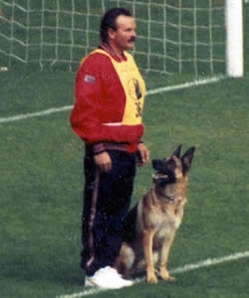
 this year we have already been honored as “America’s Leading Charity” by two National Organizations. In evaluating our present program for our Service Dogs, we have realized in a new way that one of the primary considerations, which separates Dog Wish Service Dogs from other dogs, is that our dogs are NOT trained after the fundamental type used by other organizations. We do not produce a “Guide Dog” mentality or behavior in our dogs. Our Service Dogs are actually more like “Police K9” dogs in that they operate out of a passive protective concern for their handlers.
this year we have already been honored as “America’s Leading Charity” by two National Organizations. In evaluating our present program for our Service Dogs, we have realized in a new way that one of the primary considerations, which separates Dog Wish Service Dogs from other dogs, is that our dogs are NOT trained after the fundamental type used by other organizations. We do not produce a “Guide Dog” mentality or behavior in our dogs. Our Service Dogs are actually more like “Police K9” dogs in that they operate out of a passive protective concern for their handlers. and cause critical problems for their care-takers. A dog trained to be focused, vigilant, and diligent, who is genetically instinctive, and given advanced special conditioning, to provide a passive protection, that only they could provide, can be an invaluable asset for any handler.
and cause critical problems for their care-takers. A dog trained to be focused, vigilant, and diligent, who is genetically instinctive, and given advanced special conditioning, to provide a passive protection, that only they could provide, can be an invaluable asset for any handler.
